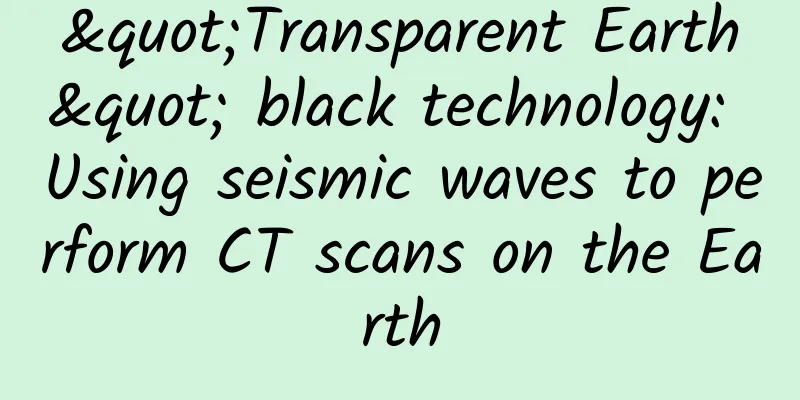"Transparent Earth" black technology: Using seismic waves to perform CT scans on the Earth

|
Major events on Earth are often related to its internal structure. For example, a volcanic eruption is the phenomenon of liquid magma inside the Earth erupting onto the surface. We know that the Yellowstone Volcano National Park in the United States is the largest land volcanic activity area on Earth, and has experienced super eruptions in history. The volcanic geothermal activity there has always been very active, and scientists have been monitoring the distribution and activity of underground magma. According to a new research report, there is more magma stored in the crust under the Yellowstone volcano vent than originally thought, and there is a possibility of another major eruption. So how do scientists know the structure of the earth's crust several thousand to tens of kilometers below? There are two ways to understand the internal structure of an object. One is to cut it open, just like cutting a watermelon. After opening it, we can see the inside of it clearly. Human body examination or treatment is also often completed through surgery. Of course, modern technology can detect microscopic structures in the body, such as blood vessels, polyps, tumors, etc., without direct contact with the human body. For example, the very popular "CT" technology, the full name is "computerized tomography". CT diagnosis uses X-rays to scan the human body to obtain a large amount of data. Through complex and large-scale computer calculations, the image formed by the X-rays is drawn on a "fault" film, so that the naked eye can identify the subtle structure and variation of the detected part. The working principle of CT is that the instrument emits X-rays to a certain part of the human body. Different tissues and organs of the human body have different absorption capabilities for X-rays. Therefore, the same beam of X-rays undergoes different degrees of changes after passing through different tissues and organs of the human body. At this time, this difference is converted into an image that is easy for us to interpret, and it can be used for diagnosis. The picture comes from Tuchong.com Similar technology can also be used to detect the internal structure of the earth. But the earth is different from the human body. The human body is small, and a common CT machine can perform three-dimensional scanning in all directions. But the earth is too big, and we can't make a huge CT machine to wrap the earth for three-dimensional scanning. Therefore, it is more difficult to do CT scans on the earth, and more "black technology" is needed. In fact, scientists have been working for nearly a hundred years to understand the internal structure of the earth. Based on the principles and ideas similar to CT technology, scientists replaced X-rays, an electromagnetic wave, with elastic waves generated by the vibration of objects, such as seismic waves, and obtained the internal structure of the earth based on more powerful computer computing technology. In 1975, scientists developed seismic reflection imaging technology, laying the foundation for the widely used seismic tomography today. It can map the underground structure through seismic exploration methods and is used to find oil and gas deposits. This method requires the use of seismic waves generated by earthquakes. For detection at depths of several hundred meters to several thousand meters, we can use seismic waves generated by artificial explosions. For example, in oil exploration, artificial earthquakes are widely used to generate seismic waves of a specific intensity to detect whether there is oil in the strata. By the same principle, if there are rocks of different properties deep in the earth, the propagation direction and speed of seismic waves will also change, and we can detect the interface of the layered structure. Of course, for the earth with a radius of more than 6,000 kilometers, the seismic waves caused by artificial earthquakes cannot reach the deep earth, and it is impossible to detect the physical information there. At this time, it is necessary to achieve this through natural earthquakes with larger magnitudes. From this perspective, while earthquakes cause natural disasters, they also provide scientists with opportunities to explore the interior of the earth. In order to better understand how the internal structure of the earth is known, we need to know the differences in the propagation speed of seismic waves in different substances. Scientists decompose seismic waves into transverse waves and longitudinal waves based on the propagation characteristics of seismic waves. The speed of both waves will increase as the density of the rock increases. However, when encountering liquid substances, the speed of longitudinal waves will be significantly reduced, and the propagation speed of transverse waves will be directly reduced to 0. In other words, transverse waves cannot pass through liquid substances, while longitudinal waves can slowly pass through liquid substances. At the beginning, we talked about the existence of a large magma reservoir under the Yellowstone Plateau, which was also detected by seismic methods. Because when seismic waves pass through magma containing melt, their longitudinal wave speed will be significantly reduced, and the transverse wave will be reduced to 0. Scientists can obtain the depth and size of the magma reservoir through a large number of calculations and inversions. Using this method and principle, scientists analyze the changes in the speed of transverse and longitudinal waves received by seismographs distributed around the world, analyze the density differences of underground materials, and whether there is liquid matter to divide the internal structure of the earth. Through the analysis of a large amount of seismic data, the internal layers of the Earth have been well defined. This is what we often hear, that the Earth mainly consists of three major layers: the crust, mantle and core. Specifically, the crust is a hard outer shell composed of solid rock on the surface of the earth. The thickness of the crust varies. The oceanic crust is thin, generally 5 to 10 kilometers; the continental crust is thick, with an average thickness of 39 to 41 kilometers. The crust will be thicker in places with high mountains, with the thickest reaching 70 kilometers, such as the Qinghai-Tibet Plateau. The mantle is the part from the bottom of the crust to the outer core. The top boundary is called the Moho interface and the bottom boundary is the Gutenberg interface. The depth is 2,900 kilometers deep and accounts for 80% of the total volume of the earth. According to the change of the velocity of seismic waves, the mantle is divided into the upper mantle and the lower mantle. There is an asthenosphere above the upper mantle. The temperature is very high, the rocks are partially melted and can flow slowly. Scientists have inferred that the asthenosphere is the main source of volcanic magma, and the movement of the earth's plates is also related to it. The innermost part is the core. The core is mainly composed of metals such as iron and nickel, and is about 3,400 kilometers thick. According to the changes in seismic waves, the core can be divided into two layers: the outer core and the inner core. The outer core is a molten metal substance, and the movement of the liquid substance in the outer core forms the earth's magnetic field. The inner core is a solid metal ball with extremely high density, and the super-strong pressure squeezes iron atoms and atoms tightly together. At present, my country is performing CT scans on the earth, making it a "transparent earth". It not only uses seismic tomography, but also electromagnetic wave tomography. It is not only used in the exploration of energy minerals such as oil and natural gas, but also in the exploration of metal minerals, non-metallic minerals, and water vapor minerals, making a huge contribution to the development of my country's mining industry. This article is a work supported by Science Popularization China Starry Sky Project Author: Xiao Long Reviewer: Zhang Yuxiu (Associate Professor, School of Earth and Planetary Sciences, University of Chinese Academy of Sciences) Produced by: China Association for Science and Technology Department of Science Popularization Producer: China Science and Technology Press Co., Ltd., Beijing Zhongke Xinghe Culture Media Co., Ltd. |
>>: One drop of water can generate electricity six times. This is how it works.
Recommend
Re/code editor tries out iOS 9: Upgrading is not recommended at this time
Apple recently released a beta version of iOS 9 a...
Super detailed analysis of advertising monetization related indicators! Recommended collection~
Advertising monetization is becoming increasingly...
China Association of Automobile Manufacturers: A brief analysis of the sales of key enterprise groups in the automobile industry from January to July 2023
According to statistics and analysis by the China...
NDRC: Strategic emerging industries will be increased and China Export-Import Bank will provide no less than 800 billion yuan in financing
The National Development and Reform Commission re...
Super practical! Let’s talk about icon design process and tips
Icon design requires proficiency in the use of so...
Super detailed business logic process of login and registration
Login and registration are reflected differently ...
Mobile hybrid application Hybrid App development practice
[Introduction] In recent years, with the increase...
Orange high temperature warning! The highest temperature in many places can reach above 37℃. How to deal with the "burning" test?
The Central Meteorological Observatory continued ...
Article: Ma Yili divorces netizens: This is the difference between Huawei Mate and P series
[[271997]] Wang Xuehan and Ma Yili announced thei...
Three Contradictions About Mini Programs
On January 9, 2017, WeChat Mini Programs were off...
This kind of paper straw will not soften when soaked. Would you like to try it?
Produced by: Science Popularization China Author:...
Hotel WeChat official account operation plan, how to operate WeChat official account?
Recently, I happened to be involved in the operat...
With 8 “world firsts”! Where does Lufeng’s reputation as the “hometown of dinosaurs” come from?
The Anachuan Jielong on display at Kunming Changs...
Baidu invested in Uber, Li Yanhong's intention is not "taking a taxi"
The day before yesterday afternoon, the cross-bor...
Kuaishou Account Practical Operation Guide
1. How to formulate an operation plan for a new a...









